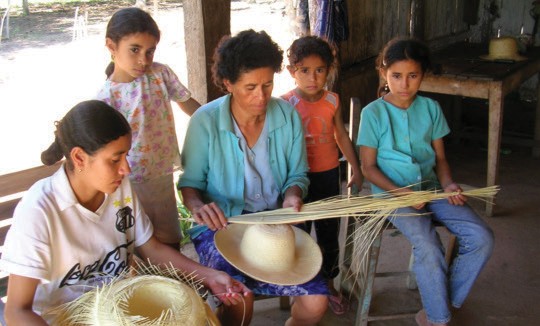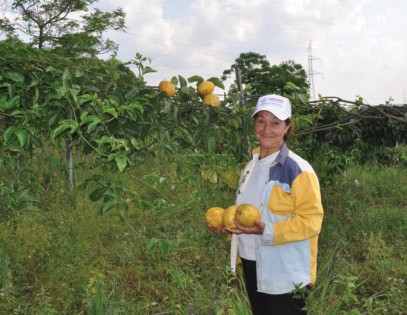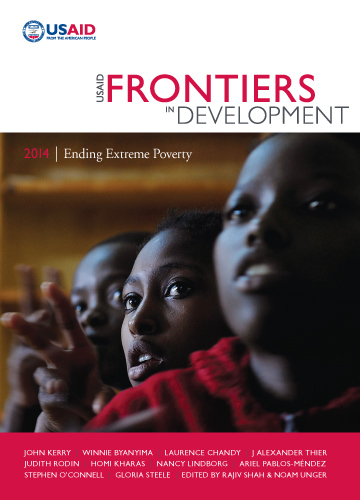Steven E. Hendrix
Paraguay’s Poverty Stoplight pilot project shows how a relatively low-cost approach can help us better understand the drivers of poverty and help families improve their welfare. Fundación Paraguaya, a local non-governmental organization (NGO), developed this approach through reliance on new technologies, marketdriven incentives and financial sustainability and with an eye toward empowering women.
In its first three years of operation, Poverty Stoplight used just $500,000 from USAID and leveraged another $1 million from other donors and a parallel microlending program to help improve the welfare of 18,000 families, or about 92,000 people. This replicable project illustrates how relatively small amounts of foreign assistance can generate promising, tangible steps toward reducing poverty.
An inventive approach toward multidimensional poverty
Fundación Paraguaya created Poverty Stoplight to understand and address the household-specific constraints that keep families below the poverty line. The approach uses household-level poverty assessments and action plans and delivers opportunities to access microcredit, support for microenterprise development and access to client networks.

The Foundation implements the Poverty Stoplight primarily through its microfinance village banks. A user-friendly poverty assessment, administered by village bank agents, lies at the heart of the approach. Families use a smart phone application or tablet program to complete a self-evaluation survey with 50 indicators. These indicators address six dimensions of poverty: income and employment, health and environment, housing and infrastructure, education and culture, organization and participation, and “interiority and motivation,” which includes measures such as self-esteem and entrepreneurial spirit.
The entirely visual survey presents three depictions for each indicator—tagged green, yellow and red—of what is typical for non-poor, poor and extremely-poor households. For housing and infrastructure, for instance, these pictures show different toilets or water sources.
Microfinance agents then work with clients to design a Family Development Plan. The families themselves identify ways to move these indicators from red and yellow to green. Agents support the process, noting opportunities for families to draw upon training, technical assistance or small loans.
Whenever the challenge requires higher family incomes, Poverty Stoplight connects interested households with opportunities for affordable, self-financing micro-franchises. These micro-franchises, designed especially for women, include activities such as jewelry-making, selling non-prescription eyewear and door-to-door cleaning services.
The Foundation set a broad goal of helping clients increase their incomes by about $120 per month, roughly doubling their income. Over twothirds of clients surpassed this goal in less than one year. Key to success has been getting clients to think of themselves less as beneficiaries and more as empowered agents of change.
The Foundation has since secured a small donation from the Inter-American Development Bank to develop new micro-franchises for program clients, based on market and client surveys. To help households make progress on other indicators, the Foundation established a client network that functions in ways similar to a buyers’ club in the United States, allowing members privileged access to certain vendors and providers, including group health insurance and recreational opportunities.
While USAID funded Poverty Stoplight’s development, the program itself is fully paid for by the Foundation’s micro-credit lending activities, making the program fully self-sustaining. Micro-credit lending finances family needs in areas such as home improvements, education and health and helps them meet the goals in their Family Development Plans. Credit advisers meet with clients once a month to assess progress and offer advice.
Beyond a single project

Poverty Stoplight’s benefits are extending beyond the program’s direct clients. Fundación Paraguaya has used the tool to identify issues faced by its own employees and, as a result, provide training to reduce sexual harassment and deliver targeted assistance to some of the poorer households.
Civil society organizations in Paraguay and beyond have been using the Stoplight. British NGO Volunteer Uganda has collaborated with Fundación Paraguaya to adapt the program and has already conducted an initial survey of 5,000 families. In Tanzania, Fundación Paraguaya is working with Italian NGO Acra to launch the program for family members of students at three schools that cater to poor children. The American University of Nigeria has adapted the Poverty Stoplight for local linguistic use. Choice Humanitarian, a faith-based NGO in Utah, has expressed interest in supporting the Poverty Stoplight in Guatemala, and Mexican NGO Promujer has offered to help the Foundation focus a program in the Mexican city of Bachuca.
Telling the full story
Rates and indexes do not tell the full story of poverty. According to the World Bank, Paraguay’s poverty rate is 35 percent. But who are the poor? Where do they live? Why are they poor?
Poverty Stoplight creates geo-referenced maps of communities with layers of information as to why households are poor. It can help policymakers and NGOs geographically target their services and, just as important, ensure that public services are more responsive to community needs.
When they know why people are poor, policymakers can target interventions for the cause of a problem, not just the problem itself. If motivation is the issue, then interventions should focus in this area. If it is access to credit, then financing may be the solution. If people lack knowledge, perhaps training is the answer.
When they know why people are poor, policymakers can target interventions for the cause of a problem, not just the problem itself.
By helping policymakers pick the right tool for the cause, not the problem, the Stoplight has the potential to help improve the welfare of poor communities while strengthening governments’ accountability to citizens.
The Poverty Stoplight has been criticized for “cherry picking” its beneficiaries. After all, the households that become clients of Fundación Paraguaya’s microfinance institutions are more likely to be creditworthy and possess some entrepreneurial skills, compared to poorer households. Although this selection bias may exist, the Stoplight nevertheless remains a promising diagnostic tool. It allows us to map poverty, help those who can move out of poverty to do so and focus assistance very narrowly on the small number of people remaining who still require a helping hand.
The Poverty Stoplight still needs to be rigorously evaluated. For instance, how do poverty trends among participating households compare to those in non-participating households? How sustainable are the gains made by participating households and communities? And how have findings shaped government spending? These are but a few of the questions that remain.
Nevertheless, if a creative, $500,000 program can help 18,000 households improve their welfare in as little as a year or two, imagine how much more we can accomplish if a national government or donor scales up this kind of approach.
Steven E. Hendrix recently completed four years as assistant mission director in USAID/Paraguay and is now the supervisory program officer with USAID/ Nigeria. The views expressed in this essay are his own and do not necessarily represent the views of the United States Agency for International Development or the United States Government.
Frontiers in Development
Section 1: Understanding Extreme Poverty








Comment
Make a general inquiry or suggest an improvement.